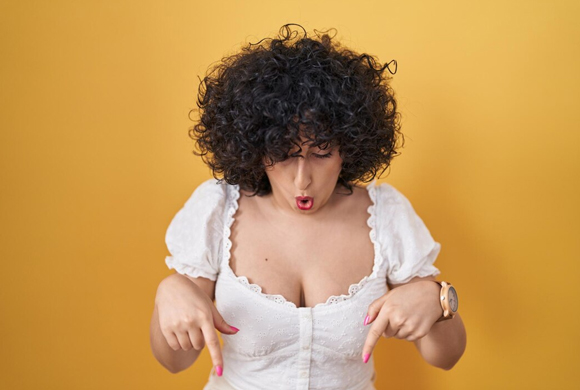When you think of acne, you might picture it on the face. However, pimples can appear almost anywhere on the body, including your arms, back, neck, and even on your breasts. These pimples are known as breast acne or boobne. While they may be annoying, pimples on breast and underboob rashes are usually not a cause for concern. Just like facial acne, it can be managed with a good bra and skin care.
Why Do You Have Pimples on Your Breasts?
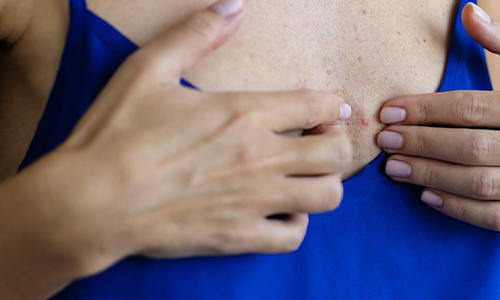
Research indicates that approximately 15% of women experience body acne, with prevalence rising during periods or hormonal fluctuations.In some studies, over 30% of adults have experienced breast acne at least once, indicating that it’s a familiar and manageable condition.
The causes of pimples on your breasts are similar to acne on other body parts. Here are some common triggers:
Excessive Sweat
Sweat trapped on the skin can mix with oils and bacteria, clogging pores and leading to pimples on your breasts. Dead skin cells can also clog pores on the breasts, resulting in pimples/acne.
Buildup of Sebum
Sebaceous glands produce an oily substance called sebum. When excess sebum combines with dead skin cells, it can clog hair follicles on the breasts, resulting in pimples.
Bacterial Infection
Bacteria on the skin can inflame clogged pores, creating pimples or pustules. When hair follicles on the bust get infected by bacteria, there are chances that they might turn into boils.
Yeast Infection
Trapped sweat and moisture can create an environment for yeast growth, leading to pimple-like spots under the breast, especially on the skin folds. Pimples caused by yeast infections can even lead to itching or burning.
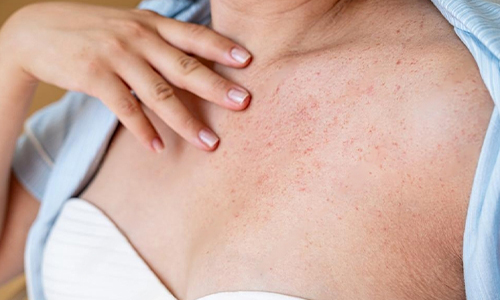
Hormonal Fluctuations
Hormones, particularly during menstrual cycles, stress, or pregnancy, can increase sebum production, which may cause acne on the breasts.
Dietary Choices
A diet high in refined carbs, trans fats, or dairy may increase acne risk, though the effects vary by individual.
Tight Lingerie/Outfits
Wearing tight bras or clothing that are not breathable can trap heat and sweat, irritating the skin and leading to acne. So, opt for outfits made from breathable fabrics. Clothing made from materials that cause rashes or irritation must also be avoided.
Medical Conditions
Sometimes, acne can be a side effect of medications or related to underlying health conditions.
Body Lotions and Creams
Thick lotions, sunscreens, or scented products can clog pores, especially if they’re not non-comedogenic.
Types of Breast Acne
Different forms of breast acne can appear, each with unique characteristics.
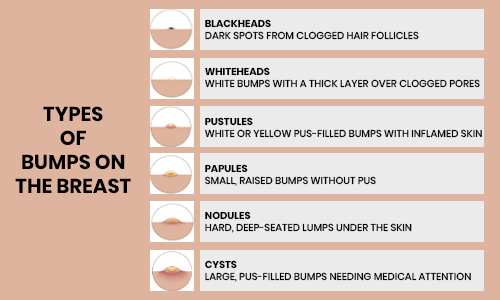
Type |
Description |
| Blackheads | Dark spots caused by clogged hair follicles. |
| Whiteheads | White bumps caused by a thick layer of skin over clogged pores. |
| Pustules | White or yellow pus-filled bumps surrounded by inflamed skin. |
| Papules | Small, inflamed bumps without pus. |
| Nodules | Hard, deep acne that develops under the skin. |
| Cysts | Severe pus-filled acne that may require medical attention. |
| Folliculitis | Small red or white bumps and inflammation of hair follicles around the breasts. |
| Furuncle | A painful, pus-filled boil develops due to bacterial infection around a hair follicle on the breasts. |
Treatment for Pimples on Your Breasts
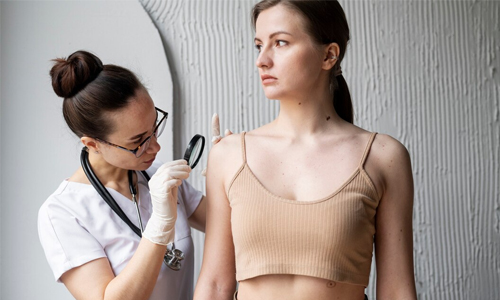
In most cases, you don’t need intensive treatment for minor pimples. However, these simple remedies can help clear up boobne.
Use Acne Ointment
Creams containing salicylic acid or benzoyl peroxide can treat and prevent acne. Look for products suited to your skin type.
Use Medicated Body Wash
A medicated body wash with antibacterial properties can help manage acne on the body.
Wash Your Bedsheets Regularly
Did you know that dead skin cells from your body and bacteria can accumulate on your bedsheets overnight? If you keep using the same sheets continuously for days, they might cause breast acne. So, make sure you wash your sheets regularly to stay away from this problem.
Use Mild Detergents
Harsh detergents used for washing bras and outfits are another cause of acne on boobs. It’s wise to use mild detergents to wash your lingerie and outerwear.
Choose Non-Comedogenic Products
Use lotions, sunscreens and creams labelled “non-comedogenic” to reduce the chances of clogged pores.
Pay Attention to Your Diet
Greasy, oily or deep-fried foods are another major cause of boobne. Try to avoid such items in your daily diet and add more fresh vegetables, fruits and protein-rich foods.
Reduce Stress
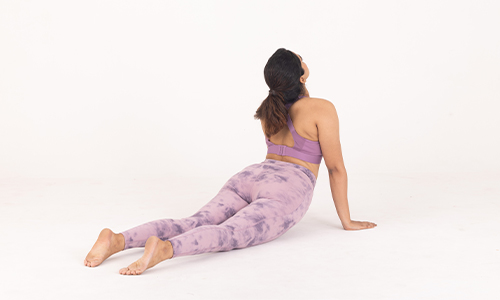
High stress levels can lead to hormonal imbalances, which may aggravate fight acne. Consider stress-reducing activities like yoga, meditation, or physical exercise.
Wear Breathable Fabrics
Opt for bras and clothes made from breathable materials like cotton to keep the skin cool and reduce sweat buildup.
Shower After Exercise
Washing off sweat and bacteria right after a workout can help prevent acne.
FAQs About Pimples on Breasts
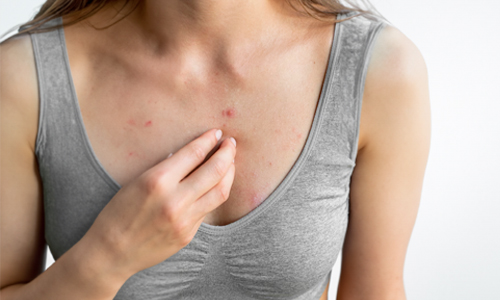
How Long Will Breast Acne Last?
The duration of breast acne varies based on the type. Whiteheads and blackheads often disappear within a few days, while deeper forms like nodules or cysts may persist longer. Consistent skin care can help speed up the healing process.
Are Pimples on Breasts a Sign of Cancer?
No, typical pimples are small, raised spots that resolve on their own. However, if you notice symptoms like rapid growth, swelling, dimpling, or persistent itching, consult a healthcare professional to rule out other conditions.
When Should You Consult a Doctor?
See a doctor if the acne becomes painful, doesn’t respond to typical treatments, or shows signs of infection, such as increasing size, pain, or colour changes.
Can Breast Acne Be Prevented?
Yes, you can minimize the risk by maintaining good hygiene, using breathable fabrics, and avoiding overly tight clothing. Using non-comedogenic skincare products and washing off sweat after exercise can also help prevent breakouts.
Does Menstrual Cycle Affect Breast Acne?
Yes, hormonal fluctuations during the menstrual cycle can lead to breast acne. Some people may experience more acne just before their period due to a rise in certain hormones that stimulate sebum production.
Are There Any Foods That Trigger Breast Acne?
Some people find that dairy or high-glycemic foods may worsen acne, although the effects vary by individual. A balanced diet rich in whole foods and low in refined sugars may help manage boobne for some individuals.
What is a Furuncle on the Breast?
A furuncle on the breast is a painful, pus-filled bump caused by a bacterial infection in a hair follicle, often due to friction, sweat, or irritation.
How Can I Treat a Furuncle on My Breast?
Treat with warm compresses and avoid squeezing; see a doctor if it’s large, painful, or doesn’t drain naturally, as antibiotics may be needed.
Treat Your Pimples the Right Way!
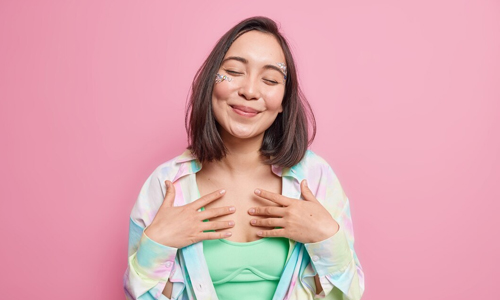
Final Notes
Pimples on breast are usually normal and can be managed with a well-fitted bra, self-hygiene, a balanced diet, and appropriate body care products. If you need additional support, don't hesitate to seek medical advice.

